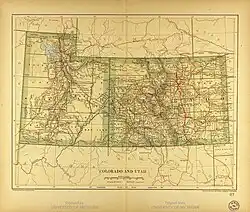
Colorado’s historical migration routes reflect centuries of dynamic movement that have shaped the state’s diverse cultural landscape and economic development. From Indigenous peoples traversing the region’s high plains and mountain passes long before European contact, to the waves of gold seekers and homesteaders arriving via prominent trails, each migration brought distinct cultural influences and spurred critical changes in settlement patterns. These routes highlight the interplay between environmental conditions, resource opportunities, and national forces such as the Homestead Act and railroad expansion.
Research your ancestors on MyHeritage
List of Colorado historical migration routesList of Colorado historical migration routes
| Time Period | Ethnic Group | Origination Location | Arrival Location | Motivating Factors |
|---|---|---|---|---|
| Pre-18th century | Various Indigenous peoples (including Ute, Arapaho, Cheyenne) | Great Plains, Southern Rocky Mountains | Regions throughout present-day Colorado (e.g., San Luis Valley, Front Range) | Seasonal hunting, gathering, and trade routes shaped by nomadic traditions and tribal alliances |
| Early 18th–19th centuries | Spanish settlers and traders | Northern New Spain (present-day Mexico, New Mexico) | Southern Colorado (San Luis Valley, along the Rio Grande) | Extension of Spanish colonial frontier, religious missions, trade (e.g., wool, livestock) |
| 1821–1880 (Santa Fe Trail era) | Anglo-American and Hispanic traders, trappers | Independence, Missouri, and northern Mexico | Along the Arkansas River corridor and southern Colorado settlements | Trade between U.S. and Mexico; fur trapping; establishment of trading posts |
| 1830s–1840s (Old Spanish Trail branches) | Mexican traders, American frontiersmen | New Mexico, California | Southern and western Colorado (via southwestern routes) | Expanding trade in wool, mules, and manufactured goods; exploration |
| 1840s–1860s (Cherokee Trail, Overland Trail, Smoky Hill Trail) | Anglo-American pioneers, some Cherokee and other Native groups | Midwestern states (e.g., Kansas, Missouri), Indian Territory | Denver and Front Range region | Westward expansion, gold-seeking (Pikes Peak Gold Rush), homesteading opportunities |
| 1858–1860s (Colorado Gold Rush) | Diverse groups (Anglo-Americans, Germans, Irish, other European immigrants) | Eastern US and European ports | Denver, Central City, other mining camps in the Rockies | Discovery of gold, “Pikes Peak or Bust” gold rush fervor |
| 1862–1880s (Homestead Act and railroad expansion) | Anglo-Americans, Germans, German Russians, Scandinavians | Midwestern and Eastern US, some from Europe | Eastern Colorado plains, Front Range farming communities | Homestead Act land grants, [1]railroad-promoted settlement, agricultural opportunities |
| 1870s–1890s (Railroad labor routes) | Chinese laborers, Irish laborers | California and Eastern US | Railroad expansion corridors (Denver, Pueblo, and various railroad towns) | Employment on transcontinental and branch rail lines, seeking economic opportunities |
| Late 19th–early 20th century | Hispanics, especially from New Mexico and Mexico | Northern New Mexico, Central Mexico | Southern Colorado (San Luis Valley, Pueblo, Trinidad) and Denver | Agricultural work, railroad jobs, mining, escape from political instability |
| Early–mid 20th century (Great Migration phases) | African Americans | Southern states (Texas, Louisiana, Mississippi, etc.) | Denver’s Five Points area, Colorado Springs, Pueblo | Manufacturing and service jobs, escape from Jim Crow laws, better social opportunities |
| 1930s (Dust Bowl era) | “Okies” and “Arkies” (primarily white American farmers) | Oklahoma, Arkansas, Texas, Kansas | Eastern Colorado farming regions, urban centers (Denver) | Environmental disaster in the Great Plains, search for farm or urban jobs, New Deal programs |
| Post-1945–1970s | Diverse post-war migrants (including veterans, high-tech workers) | Nationwide, including Midwest & East Coast | Denver metro area, Colorado Springs, Boulder | Booming industrial and technology sectors, GI Bill opportunities, quality of life (mountains, climate) |
References
- ↑ Homestead Act (1862). US National Archives

